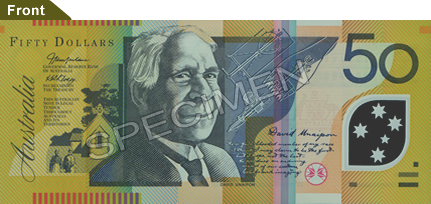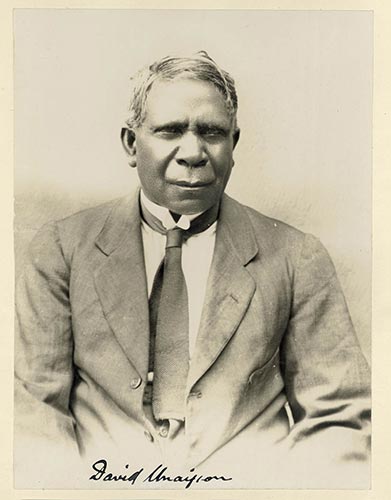
David Unaipon - Aboriginal Inventor and writer on the $50 note
 Australian Fifty-dollar note
Australian Fifty-dollar note
You'll see David everywhere in Australia as he features on the Australian $50 note. The background features the Raukkan mission and Unaipon’s mechanical shears.
Born in 1872 at Point McLeay Mission (Raukkan) on the banks of Lake Alexandrina in the Coorong region, Unaipon was the fourth of nine children. Unaipon began his education at the age of seven at the Point McLeay Mission School and soon became known for his intelligence.
Unaipon left school at 13 to work as a servant for C.B. Young in Adelaide where Young actively encouraged Unaipon’s interest in literature, philosophy, science and music. In 1890, he returned to Point McLeay where he was apprenticed to a bootmaker and appointed as the mission organist. In the late 1890s he travelled to Adelaide but found that his colour was a bar to employment in his trade and instead took a job as storeman for an Adelaide bootmaker before returning to work as book-keeper in the Point McLeay store.
He was later employed by the Aborigines’ Friends’ Association as a deputationer, in which role he travelled and preached widely, seeking support for the Point McLeay Mission. Unaipon retired from preaching in 1959 but continued working on his inventions into the 1960s.
Inventor
 Unaipon took out provisional patents for 19 inventions but was unable to afford to get any of his inventions fully patented. His most successful invention (provisional patent 15 624), was a shearing machine that converted curvilinear motion into the straight line movement which is the basis of modern mechanical shears. It was introduced without Unaipon receiving any financial return and apart from a 1910 newspaper report acknowledging him as the inventor, he received no credit.
Unaipon took out provisional patents for 19 inventions but was unable to afford to get any of his inventions fully patented. His most successful invention (provisional patent 15 624), was a shearing machine that converted curvilinear motion into the straight line movement which is the basis of modern mechanical shears. It was introduced without Unaipon receiving any financial return and apart from a 1910 newspaper report acknowledging him as the inventor, he received no credit.
Other inventions included a centrifugal motor, a multi-radial wheel and a mechanical propulsion device. He was also known as the Australian Leonardo da Vinci for his mechanical ideas, which included pre World War I drawings for a helicopter design based on the principle of the boomerang and his research into the polarisation of light. He spent much of his life attempting to achieve perpetual motion.
Writer & Lecturer
Unaipon was obsessed with correct English and in speaking tended to use classical English rather than that in common usage. His written language followed the style of John Milton and John Bunyan.
Unaipon was inquisitively religious, believing in an equivalence of traditional Aboriginal and Christian spirituality. His employment with the Aborigines’ Friends’ Association collecting subscription money allowed him to travel widely. The travel brought him into contact with many influential people sympathetic with the cause of Aboriginal rights, and gave him the opportunity to lecture on Aboriginal culture and rights.
Unaipon was the first Aboriginal writer to publish in English, the author of numerous articles in newspapers and magazines, including the Sydney Daily Telegraph, retelling traditional stories and arguing for the rights of Aborigines.
Some of Unaipon’s traditional Aboriginal stories were published in a 1930 book, Myths and Legends of the Australian Aboriginals, under the name of anthropologist William Ramsay Smith. They have recently been republished in their original form, under David Unaipon’s name, as Legendary Tales of the Australian Aborigines.
In 1936, he was reported to be the first Aborigine to attend a levée (government reception), when he attended the South Australian centenary levée in Adelaide, an event that made international news.
Unaipon proposed to the government of South Australia to replace the office of Chief Protector of Aborigines with a responsible board. He was arrested for making an attempt to provide a separate territory for Aborigines in Central and Northern Australia.
Unaipon returned to his birthplace in his old age, where he worked on inventions and attempted to reveal the secret of perpetual motion. The last full-blooded member of the Portaulun (Waruwaldi) tribe, Unaipon died in the Tailem Bend Hospital on 7 February 1967 and was buried in the Raukkan (formerly Point McLeay Mission) Cemetery. He was survived by a son.
Legacy and Tributes
An interpretive dance based on Unaipon’s life, was performed by the Bangarra Dance Theatre. The David Unaipon Literary Award is an annual award presented for the best writing of the year by unpublished Aboriginal and Torres Strait Islander authors.
The David Unaipon College of Indigenous Education and Research at the University of South Australia is named after him, as is Unaipon Avenue in the Canberra suburb of Ngunnawal.
Images: Wikipedia

Learn more about Indigenous Australians
- Aboriginals and the Murray River
- Welcome to Country
- Visit Mungo National Park
- Ngarrindjeri Dreamtime Story of Ponde and Ngurunderi
- Nildottie - Evidence of Indigenous Australians over 5,000 years ago
- Aboriginal Canoe Trees
- Murray River Aborigines (North-Western Victoria)
- Bunyips have their origins in the folklore of the Aborigines
- Take a tour with Paakantji traditional owner at Mungo
- National Landscapes
Tell your friends you found this at murrayriver.com.au!
Copyright Discover Murray 2025. This site or any portion of this site must not be reproduced, duplicated, copied, sold, resold, or otherwise exploited for any commercial purpose that is not expressly permitted by DISCOVER MURRAY.






 The Royal Edinburgh Military Tattoo 2023 - Arts On Screen
The Royal Edinburgh Military Tattoo 2023 - Arts On Screen An Afternoon Of Classical Piano
An Afternoon Of Classical Piano CREEDENCE CLEARWATER COLLECTIVE
CREEDENCE CLEARWATER COLLECTIVE Big Band Christmas Bash 2023
Big Band Christmas Bash 2023